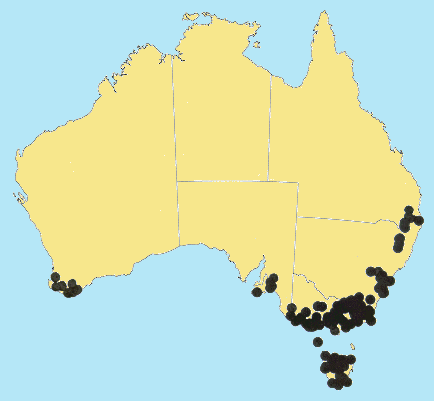Anthoxanthum odoratum* L. Sp. Pl.
28 (1753).
Classification. (GPWG 2001) : Subfamily Pooideae.
Tribe Poeae.
Type of Basionym or
Protologue Information: LT: Anon., (LINN-46.1). LT designated by
Cope in Jarvis et al., Regnum Veg. 127: 19 (1993).
Key references
(books and floras): [1878] G.Bentham, Flora Australiensis 7 (557),
[1952] C.A.Gardner, Flora of Western Australia 1 Gramineae (28),
[2002] D.Sharp & B.K.Simon, AusGrass, Grasses of Australia, [2002]
J.Wheeler, N.Marchant & M.Lewington, Flora of the South West (399), [2006]
J.Jessop, G.R.M.Dashorst, F.M.James, Grasses of South Australia (200),
[2008] S.W.L.Jacobs, R.D.B.Walley & D.J.B.Wheeler, Grasses of New South
Wales (123), [2009] A.Wilson (ed.). Flora of Australia, Vol 44A. Poaceae
2 (144).
Illustrations:
[1952] C.A.Gardner, Flora of Western Australia 1 Gramineae (27,
Pl. 6), [1984] N.T.Burbidge. rev. S.W.L.Jacobs, Australian Grasses (57), [1983] J.C.Tothill & J.B.Hacker, Grasses
of Southern Queensland (100), [2006] J.Jessop, G.R.M.Dashorst, F.M.James, Grasses
of South Australia (201, Fig. 150),
[2008] S.W.L.Jacobs, R.D.B.Whalley & D.J.B.Wheeler, Grasses of New South
Wales, 4th edn (123), [2009]. A.Wilson (ed.), Flora of Australia 44A:
Poaceae 2 (148, Fig. 22).
Derivation: L. odora,
fragrance; -ata, possessing. Strongly scented with coumarin.
Habit.
Perennial. Culms erect or geniculately ascending, stature robust to moderate or
slender to delicate, 9.5–75(–105) cm tall, 1–3 -noded. Lateral branches simple.
Leaves mostly basal. Ligule an eciliate membrane, 1–5(–7) mm long. Leaf-blades
1–31 cm long, 1.5–9 mm wide. Leaf-blade surface glabrous or indumented.
Inflorescence.
Inflorescence compound, a panicle. Panicle oblong or ovate, 1–75(–120) cm long,
0.6–1.5 cm wide.
Spikelets.
Spikelets sessile and pedicelled or pedicelled. Fertile spikelets 1-flowered,
comprising 2 basal sterile florets, comprising 1 fertile floret(s), without
rachilla extension, lanceolate, laterally compressed, 6–10.2 mm long.
Glumes. Glumes
dissimilar, thinner than fertile lemma, shiny. Lower glume ovate, membranous,
keeled, 1-keeled, 1 -nerved. Lower glume surface indumented. Upper glume
elliptic, 6.6–10.2 mm long, membranous, keeled, 1-keeled, 3 -nerved. Upper
glume surface indumented. Florets. Basal sterile florets 2 or more,
barren, without significant palea. Lemma of lower sterile floret 50 % of length
of spikelet, membranous, without keels, 4–5 -nerved, awned. Lemma of upper
sterile floret 3–3.5 mm long, awned.
Fertile lemma 1.7–2.55
mm long, without keel, 5 -nerved. Palea 1 -nerved, without keels. Lodicules
absent or vestigial. Anthers 2. Grain 2 mm long.
Continental
Distribution: Europe, Africa, Temperate Asia, Tropical Asia, Australasia,
Pacific, North America, South America, and Antarctica.
Australian
Distribution: Western Australia, South Australia, Queensland, New South
Wales, Victoria, Tasmania, Norfolk I.
Western Australia:
Drummond, Menzies, Warren. South Australia: Murray, Southern Lofty, Kangaroo
Island, South-eastern. Queensland: Darling Downs, Moreton. New South
Wales: North Coast, Central Coast, South Coast, Northern Tablelands,
Central Tablelands, Southern Tablelands, South-Western Slopes. Victoria:
East Gippsland, Eastern Highlands, Gippsland Plain, Grampians, Midlands, Otway
Plain, Otway Range, Wilsons Promontory, Snowfields, Volcanic Plain, Wannon. Tasmania:
King Island, North West, North East, West Coast, Central Highlands, Midlands,
Ben Lomond, East Coast, South West, Mt Wellington.
Notes.
Introduced. Extending S from the Darling Downs district Qld, across southern
Australia. Widespread in Europe, Asia and North America. In cooler regions in
open grassy situations from sea-level to c. 1200 m. Flowers Sept.-Feb. Fruits
Nov.-?.





